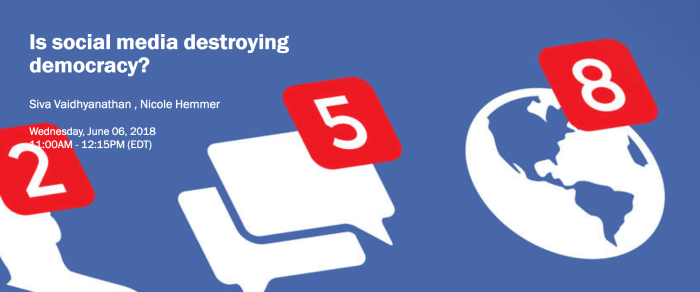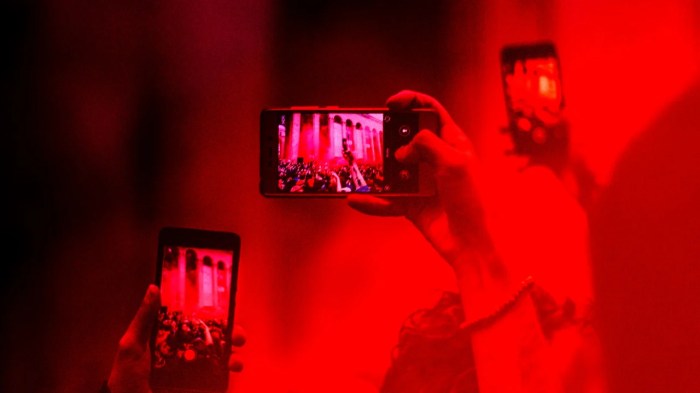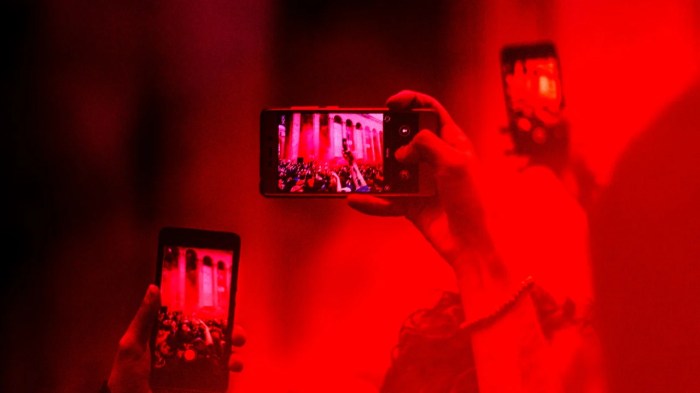Social media can destroy, often subtly chipping away at our well-being. From the pressure to present a perfect online persona to the insidious spread of misinformation, the digital world can become a breeding ground for anxiety, low self-esteem, and even addiction. This exploration delves into the multifaceted ways in which social media can negatively impact our mental health, relationships, and overall sense of self.
This blog post will examine the detrimental effects of social media, exploring how it can distort our perception of reality, hinder social skills, and even influence our self-expression. We’ll uncover the addictive nature of these platforms and compare their impact to traditional media, ultimately aiming to provide actionable strategies for navigating the digital landscape in a healthier, more balanced way.
Impact on Mental Health
Social media has become an undeniable part of modern life, connecting us in unprecedented ways. However, this constant connectivity comes with a shadow, impacting our mental well-being in significant and often subtle ways. The curated realities, constant comparisons, and pressure to project a perfect image can take a toll on our self-esteem, body image, and overall mental health. Understanding these potential negative effects is crucial for navigating the digital world responsibly.Social media platforms often present an idealized version of reality, fostering unrealistic expectations and comparisons.
This can lead to feelings of inadequacy and anxiety, as users constantly measure themselves against the seemingly flawless lives displayed online. The curated nature of these platforms often masks the struggles and imperfections inherent in human experience, further exacerbating feelings of inadequacy.
Social Comparison and Low Self-Esteem
Social media platforms often create environments ripe for social comparison. Users are exposed to carefully crafted and often unrealistic portrayals of others’ lives, including achievements, relationships, and lifestyles. This can trigger feelings of inadequacy and lead to negative self-perceptions, as individuals may begin to evaluate their own lives and experiences against the seemingly perfect lives presented online. For example, a user scrolling through photos of friends on vacation might feel envious or inadequate if they haven’t taken a similar trip themselves, even if those photos are carefully selected and don’t fully represent the experience.
Unrealistic Portrayals and Anxiety
The curated nature of social media often presents unrealistic portrayals of beauty, success, and happiness. This can lead to anxiety and feelings of inadequacy, particularly among younger demographics who are more susceptible to these pressures. For example, unrealistic beauty standards perpetuated through filters and carefully chosen photos can negatively affect body image and self-esteem, leading to anxiety and depression.
The pressure to maintain a perfect online persona can also lead to feelings of stress and anxiety, as individuals strive to meet these unrealistic expectations.
Social Media and Body Image Issues
Social media’s impact on body image is significant and well-documented. The constant exposure to idealized and often unattainable beauty standards can contribute to negative body image and eating disorders. For instance, the frequent use of filters and the emphasis on aesthetic perfection can lead to dissatisfaction with one’s own appearance. This can also be exacerbated by cyberbullying, which often targets physical attributes.
The pressure to conform to these standards can be overwhelming, leading to feelings of anxiety and depression.
Cyberbullying and Mental Health Struggles
Cyberbullying, a form of harassment that occurs online, has a profound negative impact on mental health. It can take various forms, including spreading rumors, posting hurtful comments, and creating fake profiles. The anonymity and reach of online platforms can make cyberbullying particularly damaging, as it can lead to feelings of isolation, depression, and anxiety. The persistent nature of online harassment can have a lasting effect on victims’ mental well-being.
Comparison of Social Media Platforms and their Impact on Mental Health
| Platform Name | Common User Complaints | Potential Harms | Mitigating Strategies |
|---|---|---|---|
| Pressure to maintain a perfect image, unrealistic beauty standards, fear of missing out (FOMO) | Body image issues, anxiety, depression, social comparison, cyberbullying | Limit time spent on the platform, unfollow accounts that trigger negative feelings, focus on authentic connections, engage in self-care activities | |
| Aggressive online discussions, hate speech, misinformation, constant stream of updates | Increased anxiety, stress, exposure to negativity, confirmation bias | Follow accounts that provide positive and constructive content, set boundaries for engagement, take breaks from the platform, use fact-checking tools | |
| TikTok | Short-form video content, rapid-fire trends, comparison to others’ lives, pressure to create content | Anxiety, depression, body image issues, unrealistic expectations, FOMO | Limit time spent on the platform, be mindful of trends, focus on content that inspires and motivates, prioritize real-life experiences |
| Information overload, negativity, pressure to maintain a perfect image, privacy concerns | Anxiety, stress, feelings of inadequacy, exposure to misinformation, potential for cyberbullying | Limit time spent on the platform, manage newsfeed settings, prioritize meaningful interactions, be mindful of privacy settings |
Relationship with Reality: Social Media Can Destroy
Social media has profoundly altered our relationship with reality. While offering connection and access to information, it can also create a distorted lens through which we view the world and ourselves. This distorted view often leads to unrealistic expectations and a struggle to maintain a balanced perspective. We are constantly bombarded with curated versions of others’ lives, shaping our own self-perception in ways we might not fully understand.The curated nature of online profiles often presents an idealized version of reality.
Social media can be a tricky beast, sometimes feeling like it’s actively trying to tear down our self-esteem. It can definitely be a time-suck and a breeding ground for comparison. However, brands can leverage tools like dynamic content to boost engagement. Boost conversions with dynamic content helps companies tailor their messages for maximum impact.
Ultimately, the best way to navigate this digital minefield is to be mindful of your consumption and remember that what you see online isn’t always reality, which is easier said than done. It’s a constant battle, but one worth fighting.
This can lead to feelings of inadequacy and comparison, affecting our self-esteem and mental well-being. The constant exposure to seemingly perfect lives can create a sense of pressure to conform, leading to dissatisfaction and anxiety. Ultimately, understanding how social media impacts our perception of reality is crucial for maintaining a healthy relationship with ourselves and others.
Distorted Perceptions of Reality
Social media’s ability to showcase highlights and carefully crafted narratives often creates a distorted perception of reality. Users frequently present idealized versions of their lives, careers, relationships, and accomplishments, which can lead to feelings of inadequacy and dissatisfaction. This can be particularly damaging for young people, who are still developing their sense of self and are more susceptible to social comparison.
Unrealistic Expectations
The curated nature of social media often fosters unrealistic expectations. Users are exposed to seemingly effortless successes, perfect bodies, and fulfilling relationships, leading to a disconnect from the complexities and imperfections of real life. This can result in disappointment and frustration when these idealized expectations cannot be met in the real world. Individuals might struggle with maintaining a healthy sense of self-worth and contentment.
Impact on Relationships
Social media impacts relationships in both positive and negative ways. Online interactions can foster connections with people from different backgrounds and locations, allowing for the formation of friendships and communities. However, reliance on online interactions can sometimes diminish the importance of in-person connections, potentially impacting the quality and depth of relationships. Maintaining a balance between online and offline interactions is crucial for fostering healthy relationships.
Strategies for Maintaining a Balanced Perspective
To mitigate the negative effects of social media on our perception of reality, it’s crucial to develop strategies for maintaining a balanced perspective. Critically evaluating online content, focusing on real-life experiences, and prioritizing in-person interactions are key steps. Understanding the curated nature of online personas and acknowledging the limitations of social media comparisons are essential for developing a healthy relationship with reality.
Stages of Developing a Distorted Perception of Reality
| Stage | Description | Example | Impact |
|---|---|---|---|
| Initial Exposure | Initial contact with curated online personas. | A teenager starts following influencers on Instagram who showcase lavish lifestyles and seemingly effortless success. | Beginnings of comparison, initial feelings of inadequacy. |
| Comparison and Idealization | Users begin comparing their own lives to the idealized portrayals. | The teenager notices a constant barrage of perfectly-styled photos and glamorous events. They start to question their own achievements and social life. | Increased anxiety, decreased self-esteem. |
| Internalization of Standards | The idealized standards become internalized, affecting self-perception. | The teenager starts to feel pressure to conform to the influencer’s lifestyle, including diet, appearance, and social activities. They may even begin to feel self-conscious about their own imperfections. | Negative body image, depression, social isolation. |
| Disconnection from Reality | A detachment from the complexities and imperfections of real life develops. | The teenager becomes increasingly dissatisfied with their own life and struggles to find enjoyment in their everyday activities. They prioritize online validation over personal experiences. | Impaired ability to form healthy relationships, difficulty in maintaining a balanced life. |
Impact on Social Skills
Social media has become an undeniable part of modern life, impacting our interactions and relationships in profound ways. While offering avenues for connection, excessive social media use can subtly erode crucial social skills, leading to difficulties in navigating real-world interactions. Understanding these impacts is vital for fostering healthy relationships and overall well-being.Excessive social media engagement can subtly hinder the development of vital social skills.
The curated nature of online profiles and the focus on presenting idealized versions of ourselves can lead to a disconnect from authentic self-expression and genuine interactions. This curated environment, where users often portray themselves in a highly favorable light, can inadvertently foster a sense of superficiality and disconnect from the nuances of real-world social dynamics.
Impact on Face-to-Face Interactions
Social media interactions often replace meaningful face-to-face interactions. This shift can lead to difficulties in understanding non-verbal cues, interpreting social nuances, and responding appropriately in real-time conversations. The immediacy and directness of in-person communication are irreplaceable in fostering genuine connections and understanding.For example, someone who relies heavily on online platforms to connect might find it challenging to initiate conversations in person or to gauge the emotional responses of others in a face-to-face setting.
This can manifest as awkwardness, difficulty maintaining eye contact, or a lack of understanding of social cues.
Effects on Empathy and Emotional Intelligence
Online communication often lacks the crucial context provided by non-verbal cues, such as tone of voice and body language. This can lead to misinterpretations and a diminished capacity for empathy. The lack of real-time feedback can also hinder the development of emotional intelligence, which is essential for understanding and responding to the emotions of others. Consequently, individuals may struggle to understand and respond appropriately to the emotional needs of those around them.For instance, an online argument might escalate quickly without the opportunity to acknowledge the nuances of emotion, which could have been resolved much more effectively with face-to-face interaction.
This highlights the importance of offline interaction for effective communication.
Importance of Offline Interactions
Offline interactions are crucial for building strong relationships and navigating social situations effectively. These interactions provide opportunities to develop crucial social skills, such as active listening, conflict resolution, and nonverbal communication. Strong relationships, built on a foundation of trust and understanding, often arise from consistent, in-person interactions.For example, attending a family gathering or joining a community group fosters direct, interpersonal communication that strengthens bonds and strengthens social skills in a supportive environment.
Table: Social Media Impact on Social Skills
| Social Skill | Social Media Enhancement | Social Media Hindrance | Importance of Offline Interaction |
|---|---|---|---|
| Active Listening | Potential for online discussions, providing diverse perspectives | Limited ability to interpret tone, body language, and other nonverbal cues | Face-to-face interactions allow for deeper understanding and more effective responses |
| Nonverbal Communication | Exposure to different communication styles | Over-reliance on text-based communication hinders development of nonverbal cues | Direct interaction provides feedback on body language and facial expressions |
| Conflict Resolution | Opportunities to engage in online discussions on different topics | Potential for misinterpretations, escalation, and lack of nuanced understanding | Offline communication allows for clarification, emotional processing, and constructive dialogue |
| Empathy | Exposure to diverse viewpoints | Limited ability to understand emotional context without nonverbal cues | Face-to-face interactions foster a deeper understanding of others’ emotions |
Influence on Self-Expression

Social media platforms have become powerful tools for self-expression, enabling individuals to connect with others, share their thoughts and experiences, and build communities around shared interests. However, this potential for connection is often intertwined with pressures and expectations that can hinder authentic self-expression. The curated nature of online profiles and the relentless pursuit of “likes” and validation can create a distorted view of reality, impacting how individuals perceive themselves and their worth.The constant comparison to idealized online personas, often meticulously crafted and strategically presented, can lead to feelings of inadequacy and anxiety.
This pressure to conform to unrealistic beauty standards or lifestyle portrayals can stifle genuine self-expression and lead to a sense of inauthenticity. Furthermore, the echo chambers and filter bubbles often created on social media can limit exposure to diverse perspectives, potentially reinforcing existing biases and hindering the development of critical thinking skills.
The Pressure to Present a Perfect Image
The desire to project a flawless image on social media can be a significant obstacle to authentic self-expression. Users often feel compelled to meticulously curate their online personas, concealing imperfections and insecurities to present an idealized version of themselves. This can lead to feelings of inadequacy, as the idealized portrayals often fall far short of the complexities of real-life experiences.
For instance, meticulously staged photos of vacations or meticulously planned social events can create a false sense of perfection, discouraging users from sharing their less glamorous or less perfect moments. This can, in turn, foster a culture of comparison and anxiety.
Promoting Harmful Stereotypes and Biases
Social media can inadvertently become a breeding ground for harmful stereotypes and biases. Certain platforms or communities can create echo chambers where pre-existing biases are amplified and reinforced, limiting exposure to alternative viewpoints. The spread of misinformation and hate speech can also have a detrimental impact on individuals and society. For example, harmful stereotypes about gender roles or ethnicities can be perpetuated through the selective sharing of content or through the creation of specific online communities, reinforcing negative perceptions and potentially leading to discrimination.
Social media, while offering connection, can be a real destroyer of confidence. It’s easy to get caught up comparing ourselves to others, especially when scrolling through meticulously crafted online personas. This is particularly true when looking at the often-overly-polished “about us” pages of many sizzling ecommerce sites, like sizzling ecommerce about pages. These carefully curated narratives can subtly distort our perception of reality and, ultimately, fuel anxieties about our own lives and accomplishments.
It’s a constant reminder that social media can be a tricky trap.
Strategies for Authentic Self-Expression, Social media can destroy
Promoting authentic self-expression on social media requires a conscious effort to manage online interactions. Understanding the power of curated profiles and the potential for unrealistic comparisons is crucial. Users should actively seek out diverse perspectives and challenge their own biases. Creating a balanced online presence that showcases various aspects of oneself, including imperfections and vulnerabilities, can encourage authenticity.
Also, limiting exposure to negativity and harmful content can help foster a more positive and supportive online environment.
Analyzing the Impact of Social Media on Identity Development
Analyzing the impact of social media on identity development requires a multifaceted approach. Observing how individuals present themselves online, considering the platforms they use, and analyzing the types of content they consume are crucial elements. Examining the frequency and nature of interactions, both positive and negative, with others on social media provides further insights. Furthermore, studying the ways in which individuals use social media to form and express their identities, highlighting the factors that contribute to both positive and negative experiences, provides a complete picture.
Addiction and Time Management
Social media has become an integral part of modern life, offering numerous benefits for communication and connection. However, this pervasive presence can also lead to detrimental habits, including addiction and poor time management. Understanding the potential pitfalls and developing strategies to navigate this digital landscape is crucial for maintaining a healthy and productive life.Excessive social media use can significantly impact daily routines and well-being.
This often manifests in a decreased ability to focus on tasks, leading to procrastination and a struggle to allocate time effectively. Recognizing this connection is the first step toward creating healthier digital habits.
Potential for Social Media Addiction
Social media platforms are designed with features that can be highly addictive. The constant stream of notifications, updates, and interactions creates a cycle of engagement that can be challenging to break. This can lead to compulsive checking of feeds, neglecting responsibilities, and experiencing withdrawal symptoms when access is limited. The dopamine released from these interactions reinforces the behavior, creating a powerful feedback loop.
Social media can definitely be a destructive force, draining your time and energy. But, if you’re using Facebook ads, you can harness their power for good, achieving better results. Learning strategies for better results facebook ads can help you focus your efforts and avoid getting lost in the digital noise, preventing social media from consuming you.
Ultimately, knowing how to use these tools wisely is key to controlling social media’s potentially destructive impact.
Impact on Daily Life
Social media addiction often manifests in disruptions to daily routines. For example, someone might consistently prioritize social media interactions over scheduled appointments or household chores. This can lead to feelings of guilt, stress, and a general sense of disorganization. Furthermore, the constant need to check social media can interrupt sleep patterns, contributing to fatigue and reduced productivity.
It’s important to recognize that these patterns are often unconscious and require deliberate efforts to change.
Link Between Social Media Use and Procrastination
The allure of social media can act as a powerful distraction from more demanding tasks. Users might find themselves scrolling through feeds instead of working on projects or completing necessary assignments. This procrastination can snowball, leading to feelings of inadequacy and missed deadlines. Understanding the triggers for these behaviors and actively developing alternative activities is vital in overcoming this challenge.
Disruption of Sleep Patterns and Daily Routines
Social media use often extends well into the evening hours, keeping individuals engaged long after their bodies are ready for sleep. The blue light emitted from screens can interfere with melatonin production, making it harder to fall asleep and leading to poor sleep quality. The resulting sleep deprivation can have cascading effects on daily routines, impacting mood, concentration, and overall well-being.
Importance of Setting Healthy Boundaries
Establishing clear boundaries regarding social media usage is crucial for maintaining a healthy balance. This includes setting specific times for checking social media, avoiding the temptation to check constantly throughout the day, and limiting the amount of time spent on these platforms. These boundaries need to be personalized and flexible, adjusted as needed to suit individual circumstances and goals.
Methods of Managing Social Media Addiction and Time Management
| Category | Method | Tools | Examples |
|---|---|---|---|
| Scheduling | Allocate specific times for social media use and stick to them. | Calendar apps, timers, website blockers. | Scheduling 30 minutes for social media in the morning and 1 hour before bed, using a timer. |
| Mindfulness | Become aware of the triggers and urges to use social media. | Meditation apps, journaling, mindfulness exercises. | Using a meditation app to calm down before checking social media, writing down the reasons for checking it. |
| Distraction Control | Develop alternative activities and interests to reduce the need to check social media. | Hobbies, physical activities, engaging in other interests. | Engaging in sports or reading a book instead of checking social media during downtime, focusing on hobbies. |
| Accountability | Seek support from friends, family, or professionals. | Support groups, therapy, setting social media goals with a friend. | Talking to a friend about limiting social media use, seeking support from a therapist. |
Comparison to Traditional Media

Social media has undeniably revolutionized communication and information dissemination, drastically altering the landscape of traditional media. This shift presents both opportunities and challenges, impacting societal values, public discourse, and even the very fabric of our reality. Understanding the contrasting effects of these two forms of media is crucial for navigating the complexities of the modern information age.Traditional media, encompassing print, broadcast, and film, often relied on gatekeepers – editors, producers, and journalists – to curate and filter information.
This process, while potentially prone to bias, often offered a degree of standardization and verification. Social media, conversely, operates on a decentralized, user-generated model. This allows for unprecedented speed and reach, but also introduces significant challenges in terms of verification, accuracy, and control.
Impact on Public Discourse
Public discourse has undergone a significant transformation with the advent of social media. Discussions, debates, and the exchange of ideas have become more accessible and instantaneous. However, this accessibility also fosters echo chambers, where individuals are primarily exposed to viewpoints aligning with their own, potentially hindering productive dialogue and critical thinking. The constant stream of information, often lacking in context or critical analysis, can lead to superficial engagement and difficulty in discerning fact from fiction.
Spread of Misinformation
Social media platforms are particularly vulnerable to the spread of misinformation due to their decentralized nature and rapid information flow. Misinformation, often designed to manipulate public opinion, can rapidly propagate through networks of users, gaining traction before fact-checkers can intervene.
- Methods of Spreading Misinformation: Sophisticated techniques like “deepfakes,” the creation of realistic but fabricated audio or video, can be used to manipulate public opinion by disseminating false narratives. Targeted advertising and personalized content algorithms can reinforce existing biases and expose individuals to specific narratives, often ignoring alternative viewpoints.
- Impact of Misinformation: The spread of misinformation can lead to significant consequences, ranging from social unrest to political instability. The 2016 US presidential election serves as a prime example of how manipulated information can sway public opinion and impact electoral outcomes.
Comparison of Effects on Society
Traditional media, despite its limitations, often underwent a process of verification and editing, which could limit the spread of unsubstantiated claims. In contrast, social media’s speed and reach allow misinformation to spread rapidly, potentially affecting a larger segment of the population in a shorter timeframe.
| Characteristic | Traditional Media | Social Media |
|---|---|---|
| Information Source | Often vetted by journalists and editors | User-generated content, often without verification |
| Dissemination Speed | Slower, relying on publication schedules | Rapid, instantaneous |
| Reach | Limited by geographic reach and audience segmentation | Potentially global, reaching a vast audience |
| Control | Greater editorial control over content | Limited control over content spread |
Evolution of Societal Values
Social media’s impact on societal values is multifaceted and complex. It has facilitated the rise of social movements, empowering individuals to organize and express their views. However, it has also been criticized for fostering superficiality, contributing to the spread of negativity, and exacerbating existing societal inequalities. The constant bombardment of information and curated online personas can impact individual perceptions of reality and potentially shape values in unforeseen ways.
Final Review
In conclusion, the pervasive influence of social media warrants careful consideration. While these platforms offer undeniable benefits, their potential for harm is significant. By understanding the various ways social media can destroy our mental health, relationships, and self-perception, we can develop strategies to use these tools responsibly and maintain a healthy balance between online and offline interactions. Ultimately, a mindful approach to social media use is crucial for navigating the complexities of the digital age.





